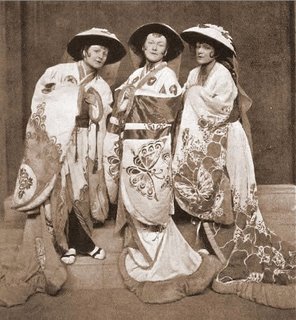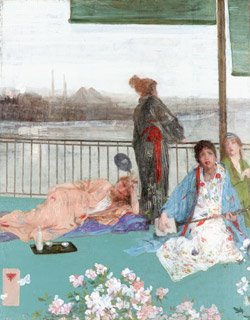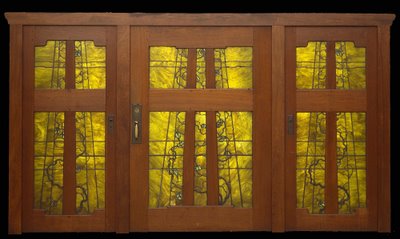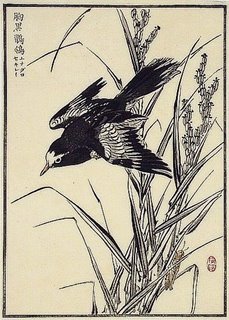23 September 2006
the mikado

while the mikado, 1885, fanned the flames of japonisme, as much as it was itself a flame, it had not dimmed throughout the twentieth century.
 the wonderful artist, designer, and maker of books, charles ricketts, designed a whole new costume scheme in the mid-twenties, right about the time when w. russell flint did the breathtaking illustrations.
the wonderful artist, designer, and maker of books, charles ricketts, designed a whole new costume scheme in the mid-twenties, right about the time when w. russell flint did the breathtaking illustrations.
this is interesting to me because we have entered a different realm here; not sure i know how to talk about it yet, but i'll try: these are not examples of artists being inspired, informed, by the newness of what they're seeing but rather maybe by the novelty. i'm not lumping this in with using women in kimono to sell corsets or whatever; here there are truly artistic results. but it is a place where "the japanese" is "the other" that we can use on "us."
nor am i selling this as politically incorrect. i for one have been grateful most of my life for what the japonisme creators brought into the world. but it is one thing to be moved by something implicit in a culture's culture, and to elaborate upon something external is something else.
it's been called the punch version of japonisme.
Labels: mikado, ricketts, william russell flint
22 September 2006
mother and child

 by completing an entire series of prints on mothers with their children, utamaro kitagawa, one of mary cassatt's favorite japanese printmakers, gave her permission to do the same. this had not been seen as a valid subject for fine art until this time.
by completing an entire series of prints on mothers with their children, utamaro kitagawa, one of mary cassatt's favorite japanese printmakers, gave her permission to do the same. this had not been seen as a valid subject for fine art until this time.daniel pipes, in a 1992 copy of society magazine, said,
"Outstanding artists directly affected by the wood blocks included Mary Cassatt, Edgar Degas, Théodore Duret, Paul Gaugin, van Gogh, Edouard Manet, Claude Monet, Edvard Munch, Pierre Renoir, and, above all, Henri de Toulouse-Lautrec. Toulouse-Lautrec derived his subject matter directly from Japanese models; his posters of the Parisian demi-monde, for example, resembled Kitagawa Utamaro's courtesans of Tokyo's pleasure quarters. Further, he imitated the Japanese in the heavy use of shadowless pure colors and other elements of design, and in his print-making technique. James Abbott McNeill Whistler had an important role in popularizing Japanese styles in the United States. Impressionists did not shy from crediting Japan. Duret called the Japanese "the first and finest impressionists," while van Gogh dubbed Japanese art 'true religion.'"
Labels: mary cassatt, Utamaro Kitagawa
american impressionists in giverney
 guy rose and frederick carl frieseke, both american impressionists, from california and from michigan, loved the kimono and parasol look women were wearing that year. in fact on the french countryside at giverney, where both lived for many years, both painted frieseke's wife one summer afternoon.
guy rose and frederick carl frieseke, both american impressionists, from california and from michigan, loved the kimono and parasol look women were wearing that year. in fact on the french countryside at giverney, where both lived for many years, both painted frieseke's wife one summer afternoon.
("through the vines," frederick carl frieseke"; on the river," guy rose)
Labels: frederick frieseke, guy rose
21 September 2006

Labels: bairei kono, walter klemm
or adoration?


we have keika hasegawa making one of his 100 chrysanthemums prints in 1893 on the left,
and on the right we have eugene seguy making his lithographs of chrysanthemums in 1904.
and on the right we have eugene seguy making his lithographs of chrysanthemums in 1904.
Labels: chrysanthemums, keika hasegawa, seguy
inspiration?
 i have selected these two images for a couple of reasons: that this may be the hokusai that whistler saw that
i have selected these two images for a couple of reasons: that this may be the hokusai that whistler saw that  inspired his own balcony painting, for one thing, and for another, to note that whistler's painting, in addition to featuring the wearing of kimono, also features a common setting from the japan- ese prints, has it's own little "fuji" in the back- ground (hokusai's is from his '36 views of fuji' series), and has the main figure, in fact most of the company, with her back to the viewer.
inspired his own balcony painting, for one thing, and for another, to note that whistler's painting, in addition to featuring the wearing of kimono, also features a common setting from the japan- ese prints, has it's own little "fuji" in the back- ground (hokusai's is from his '36 views of fuji' series), and has the main figure, in fact most of the company, with her back to the viewer.20 September 2006
japan changes too
 david asked here about the changes that went in the opposite direction. i don't know about that as much, but see that there's an exhibition at boston's mfa that bridges the gap somewhat:
david asked here about the changes that went in the opposite direction. i don't know about that as much, but see that there's an exhibition at boston's mfa that bridges the gap somewhat:Tradition and Transformation:
Japanese Art 1860-1940
Friday, January 27, 2006 -
Thursday, November 9, 2006
"Immediately following the arrival of Commodore Matthew Perry’s “black ships” in 1853, Japan cast aside its self-imposed isolation from the international community and embarked upon an unprecedented program of modernization. The nation, under the leadership of Emperor Meiji, embraced not only Western social and political institutions but also artistic ones. For some artists however, the pace of change was too sudden and they reasserted the importance of traditional themes and styles. This exhibition in the Japanese Painting Galleries explores the creative tensions that often led to such exciting syntheses of East and West."
this was called the taisho period, and there was an exhibition circulating last year called "taisho chic" the catalogue of which is still available. (the most images i could find from that show were here. it's a pdf.) i also found a gallery (where i found the above image) that seems to have a number of interesting pieces from this period.
the question was also somewhat addressed here.
(Miki Suizan, Fair Wind, 1933)
Labels: japanese impressionism, Miki Suizan
lacquerwork on japonisme blog: pt. 1
 i found this wonderful piece, "a gorgeous [lacquer- work] box by the great Hon'ami Koetsu," on an equally wonderful blog, japanese-arts, which is fascinating, but i hope he finishes it! we will no doubt see this pattern again, in silverwork from france, i presume.
i found this wonderful piece, "a gorgeous [lacquer- work] box by the great Hon'ami Koetsu," on an equally wonderful blog, japanese-arts, which is fascinating, but i hope he finishes it! we will no doubt see this pattern again, in silverwork from france, i presume.Labels: Hon'ami Koetsu
19 September 2006
the japonisme fashion
 sure, everyone is familiar with monet's wife adorning the red kimono and gesturing her fan, and standing on the hill, several times, with the para- sol; you've probably seen van gogh's copying, transliterating, japanese prints; we've seen whistler's portrait in the peacock room (see in japonisme links, below) but have we seen this one, also nearly an exact reproduction, save for style? (the title of the piece is 'variations in flesh colour and green: the balcony.' in 1889 harper's called it, 'a japanese fantasy realized on the banks of the grey thames.')
sure, everyone is familiar with monet's wife adorning the red kimono and gesturing her fan, and standing on the hill, several times, with the para- sol; you've probably seen van gogh's copying, transliterating, japanese prints; we've seen whistler's portrait in the peacock room (see in japonisme links, below) but have we seen this one, also nearly an exact reproduction, save for style? (the title of the piece is 'variations in flesh colour and green: the balcony.' in 1889 harper's called it, 'a japanese fantasy realized on the banks of the grey thames.') and there are many other impressionists, american and euopean, who followed this trend, and we'll see more of them in an ongoing way.
and there are many other impressionists, american and euopean, who followed this trend, and we'll see more of them in an ongoing way.
of course it must be said: japan-inspired clothing became the rage as well, so to some extent, the painters were painting what they saw. on the other hand, some painters kept a kimono in the studio for use with whichever model. when you see the same robe in two paintings, two different models, that's what you're seeing. (i also find myself wondering if the hairstyles are fashioned after the japanese as well.)
the japonisme craze
 in addition to japan's influence, on the deepest levels, on painting, design, architecture, music, literature, theater, dance, etc., something else happened: japonisme was cool, hip, what everyone was either into or parodied.
in addition to japan's influence, on the deepest levels, on painting, design, architecture, music, literature, theater, dance, etc., something else happened: japonisme was cool, hip, what everyone was either into or parodied.both high- and low-brow culture embraced the "new" aesthetic in numerous ways. on the first hand, as seen in the example in the previous entry, and here, many european and american painters began to work japanese items into their portraits. japanese prints and decorative screens adorned the backgrounds of paintings, women held fans, wore kimono, carried parasols. even when direct references were not made, thematically one might see lotus and other japanese symbols as motif.
Labels: bernhard gutmann
18 September 2006
"a poetic fantasy"
 "Japonisme brought to the West a new coloration, a
"Japonisme brought to the West a new coloration, anew system of decoration, and . . . a poetic fantasy in the creation of the art object." --Edmond de Goncourt
an interesting review and slide show from the washington post on two recent books on japonisme
(the blue dress; alfred stevens)
frank lloyd wright

"This exhibition explores architect Frank Lloyd Wright’s great passion for Japanese woodblock prints, which he collected and sold throughout his career. While highlighting works by some of the most celebrated Japanese print artists from the 18th and 19th centuries, this exhibition also offers insight into this source of inspiration for Wright’s architecture."not only wright, but monet, van gogh, and many others, collected and were inspired by the influx of
japanese arts and crafts.
Labels: frank lloyd wright
17 September 2006
japonisme: craftsman style

greene and greene, from pasadena, california, remain the architects perhaps most identified with craftsman-style design of homes. with the stonework, the patterns in the stained glass, and the methods of woodwork, structurally as well as aesthetically, these homes owe much inspiration to the japanese.
these stained glass doors are from the entry hall of the robert t. blacker estate in pasadena, 1907-1909, and are on display at
the de young museum in san francisco.
these stained glass doors are from the entry hall of the robert t. blacker estate in pasadena, 1907-1909, and are on display at
the de young museum in san francisco.
Labels: architecture, greene and greene





